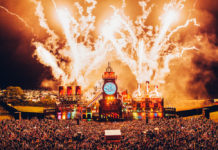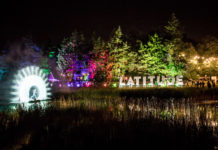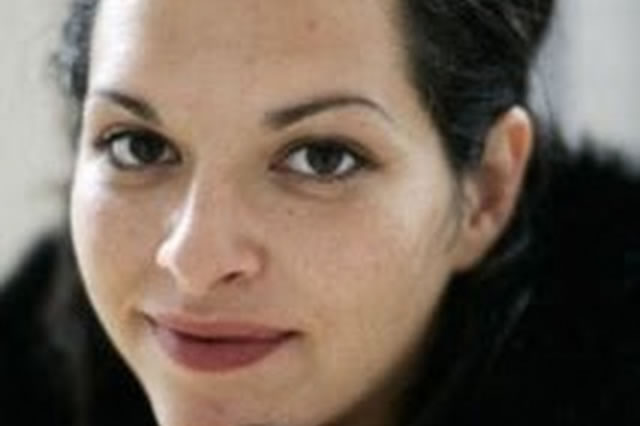
Shangri La is one of the most popular areas of Glastonbury Festival, but that doesn’t mean that we can explain what it is to our uninitiated readers. Trying to put the experience of this huge, living and breathing artistic installation into words is like trying to vocalise a Shamanic ayahusca trip to someone who’s never even drank a pint of shandy. We’ll try to do out best for you however, as it’s a special 40 acre part of the festival site that’s more than worth mentioning, opening up its gates for visitors after the rest of the stages have started to go to sleep.
Inside Shangri La there are around twenty different discos and clubs. These are not your ordinary high street venues, as you may have already guessed, with some requiring strange entrance requirements such as tattoos or moustaches. Each year progresses on with a theme developed from the previous incarnation and in recent years party-goers have been able to travel to a strange dystopian pleasure city, where the inhabitants were infected with a virus that made them hungry for non-stop hedonistic activity. This came to a head in 2012, when the narrative took on elements of the Mayan apocalypse and the destruction of this corrupt metropolis.
Following on from the disaster story, Shangri La is now becoming the Shafter-Life, exploring the relationship between spirituality, religion and partying. After seeing the show for ourselves back in 2011, we were so blown away by this amazing installation that we just had to find out more, from how the people behind it manage to pull off such an incredible show, and to see where the story’s going next. Fortunately we were lucky enough to arrange an interview with one of the chief puppet-masters, Debs Armstrong, who was able to spread some light into the world of hard work and effort that sits behind the scenes of this spectacular show.
Thank you very much for taking the interview today Debs. The first question, just for the uninitiated, is can you tell us the story of how Shangri La started off and grew into the phenomenon it is today? We’ve heard that it started off as a thank you from the kids of the travellers who gave Eavis a lot of trouble in the 1980s. How much truth is there to that tale?
Basically the travellers field turned into Lost Vagueness, and then into Shangri La. It’s the same people and the ethos. Obviously its changed quite a lot over the years. Massively in fact. It’s an evolution of what it was back in the 1980s.
Do those guys still contribute? How does that still influence Shangri La?
It’s all merged together – a combination of the people that were doing it back then, who were there in Traveller’s Field, and the new people that have come in. So like, in that sense I’m a relative newcomer, because I got involved in 2002 and I was a producer of Lost Vagueness. Lost Vagueness split out into few different areas and then became no more, and thus the famous field became Shangri La.
I notice on your website that you mention you’re trying to create a dystopian reality, akin to Blade Runner. Obviously this famous film is based on a work by Philip K Dick. Are there artists and writers who influence your work more than others and if so who are they?
That’s old news now, that was our old story. However, we like to take our inspiration and influences from a really broad range of things. This year, our alleys are based around Dante’s Seven Circles of Hell, where you’ve got special areas for different types of sin like lust, gluttony, avarice and all that sort of stuff. We’re really looking at contemporary sins like obsession with appearance, media control, spending, hoarding, banking, pride, party people and bling. Looking at sin from a voyeur’s point of view – so we’ll start taking influences from crazy things that we see on the internet, like finding out that peoples webcams can be hacked, and then you suddenly get to see all the faces of people watching internet porn. It would be hard to pin down a specific artist for influence stuff but for this years theme its Heaven, Hell and Purgatory.
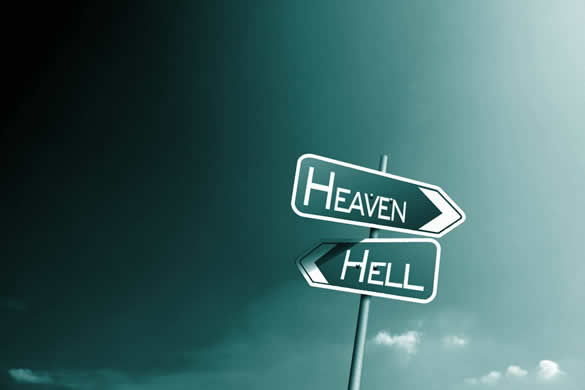
When people who’ve never been to Shangri La before ask you what you do, what do you tell them? How do you describe Shangri La to these people? What would you say to someone who’s never been before?
Basically we create a living, breathing interactive world. A film set reality that’s inhabited by performers and the audience are part of the show. We build this film set, and then we layer it up with lots of different effects. We’ve got a lot of contributing artists who provide graphics, light installations, AV and set design. We take that basic frame and we layer it up with tonnes of different artists. We have nano venues, larger venues and roaming performers, so that by the time the audience gets in there, they’re really within something rather than looking at something or just seeing a band. It’s about totally immersing our visitors into this environment. It’s really about the feeling of becoming lost and finding something that you never expected to be there.
A lot of the time people say to me, the first time they discovered Shangri La, they had no idea where they were or how they there, but they found this thing – You know that’s a big part of the festival experience is the sense of discovering something completely new that completely fascinates you. Even I still like to ditch everyone and go on a big exploration to find something that I can’t find normally. For me, this openness is a vital part of the festival picture.
How much physical work goes into setting up, maintaining and creating new facets and parts of the Shangri La experience? How soon do you have to start putting things into place and how difficult is it to be the one person who puts everything in place and joins up all the separate parts to this one giant living organism?
Physically, we’re on site for about 6 weeks. It takes about a month to build it and a couple of weeks to take it down and clean it all up. This year’s been especially hard with the new set. We started planning it in August, so I believe that it’s taken about 10 months to plan. We are really a big team. I can’t do it all by myself. I’m the Mama of the group and thus I provide a lot of the driving force, but it would be me standing in a field by myself if it wasn’t for everyone else that does all the hard work too.
I understand that you’ve been part of the free party and rave scene for some time. How much does that influence the work you do now?
Well I was actually an installation artist and I went to St Martins, and always made multi-room, multi-media installations with performers and interactive elements. Then I started doing installations at parties and realised parties were installations in their own right and could be treated as installations on a much larger scale.
I stopped doing that because really I wanted to create better quality shows and you just can’t put everything into your work if you’re doing a squat party because you’ve got the risk element of losing everything to the wrong crowd or the police. As a result I got involved in Lost Vagueness and I applied a lot of the sort of theories that I’d developed as an artist about audience participation and creating these whole worlds for people. I like doing really high quality so that’s a really important thing for me to keep pushing the boundaries of our production. I just can’t bear banners fucking gaffer taped on to walls. Everything has to be done well.
Some people have said that Glastonbury has lost its edge. Are these people stuck in a time warp, harking back to a reality that never was or do they have a point? What do you guys and girls do to ensure that your experience maintains an experimental vibe?
I think the media coverage of Glastonbury has been pretty one dimensional in its focus. It’s always all about the Pyramid Stage, people swimming in mud and bad toilets, when actually that’s only one small aspect of it. I know we’re really there to help the festival keep its edge and we’ve got others hot on our heels like Boomtown and all of those guys. I don’t mind because we wouldn’t be as influential and inspirational as we are if they weren’t pushing us, but I think that whoever saying it’s losing its edge ought to come down to Shangri La and should try to tell me that after seeing our show.
We’re doing this whole new complex, we’re calling it the Naughty Plex. It’ll make people wonder if it’s just another Shangri La initiative created by the evil administration. The heaven complex is completely new and certainly hasn’t been done before. It’s an entirely floored and covered complex of different venues, where people have to blag the admin angels to try and get a wristband and a wellie bag. What experiences they can have within there? We’ve got the Garden of Eden that they’ll have to find. Its quite revolutionary just to have a bloody uber luxury VIP area that appears to be exclusive, but it’s not actually exclusive at all, because anyone with a good blag can get in there and be really comfortable. Its clean, comfortable, carpeted and there’s nice cocktails, beautiful flowers, harpists and some incredible secret gigs. That’s a whole new thing that I expect to be copied highly in 2014.
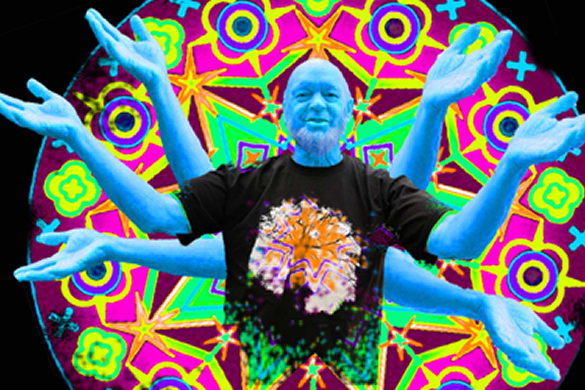
How much time do you actually get to experience Shangri La? Are you just a bag of nerves trying to hold everything together or do you have the whole Shangri La act so nailed down that once things are in place you can go off and enjoy yourself?
I usually hide. I get really agoraphobic as I’m really rinsed and I’m really tired and just like don’t want to deal with it. In my worn out state I get slightly intimidated by the crowds so like I always stay in the south east corner and I like hide in a little bar. Then when I manage to wind down a bit I do my little forays where I go and whiz around and trying to see everyone. So I don’t get out much, but this year I’m going to try to get to the park and the green fields. .
The amount of love and effort and endurance that gets poured into creating Shangri La for people – that’s what really struck me when I first visited Glastonbury in 2000. We’re still doing it for these same reasons, with our artists and workers still pouring their hearts into everything that we do. People probably think that its the same all year round. It’s not, its just a field with grass in – we have to work hard on getting every aspect of it up and working.
What’s new in Shangri La in 2013? Is there anything that of which you’re particularly proud or interested to see a reaction to?
Everything is new this year. We’ve got a massive set modelled on heaven, which is like a really beautiful minimalist architectural piece – very clean and austere – not something you’d expect to see at Glastonbury. The same with the new hell set. Both of those are designed by this guy who describes himself as a anti-architect called Andrew Croft. I’m really excited to see both of these and I think the alleyways will develop in really interesting ways over the next four years.
What we do want to keep consistent is the experience of people going into and through a space which had lots of different experiences encapsulated within it. This is now the Seven Circles of Hell. I think this year so much of our time is consumed with getting the new base right that actually the year after next will be a real smash. Then the year after that will be absolutely unbelievable, because once you get the base then year on year we can developed its depth.
So this year we’ve got loads of things that we want to do, but we won’t really have time to fully expand them. For instance we won’t have time to develop Plastic Surgery properly, because we’re so busy building everything. These ideas as developed and the performers grow with them, as more layers of detail get added on. The 2011 Shangri La was really good, but the 3 or 4 years before that it wasn’t as fantastic, because you only get one shot at it a year. Last year I looked at it and I thought to myself “now that’s what I’m talking about”. Bang! That’s what we wanted to achieve and then we scrapped it all.
What aspect of Shangri La are you most looking forward to in 2013?
I think Sunday is going to be a really special day actually on the Hell stage, as we’ve got these guys programming it together with Rudimental, Jamie Jones and all of those guys. So you know when you’re saying “oh, it’s Sunday, I don’t know what to do, I’ll just wonder round Glastonbury” – I’d just go there because its going to be like a mental all day after-party rave.
To Sum It All Up
If you’ve never been to Shangri La before and you’re going to Glastonbury this year then we’d suggest that you make a serious effort to check out this debauched spectacle at all costs. This is one of those experiences that just has to be, well experienced – there’s no other word for it. It captures the true essence of the festival universal, which is all about getting lost and finding something new that you never expected to see, and finding out that this is more wonderful than anything you could have ever planned.
We’re certainly going to be there, trying our luck at breaking into the Shafter-Life with our souls drenched in sin, as we make our way through a number of different physical embodiments of strange metaphysical dimensions. Until then we’re going to be working on our blags to get us into heaven… or hell…
For more on Glastonbury Festival click here.
Watch Shangri-La 2013 – The Shafterlife

